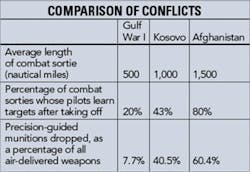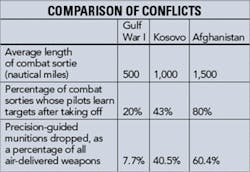Analysts: electronics are central to 21st century warfare tactics
By Ben Ames
SAN DIEGO — U.S. military leaders know how to win a war with the Soviet Union — they have refined their plans for decades. But how do we defeat terrorists and their guerilla tactics? A new study of America's recent battles has the answer.
Analysts at Northrop Grumman examined trends in the first three post-Cold War conflicts fought by American troops: the first Persian Gulf War of 1991 (Gulf War I), Allied Force (Kosovo, 1999), and Enduring Freedom (Afghanistan, 2001).
Then they tested their predictions against the U.S. experience in the second Persian Gulf War of 2003 in Iraq (Gulf War II).
They were right on target, said Robert Haffa, director of Northrop Grumman Analysis Center. He spoke Dec. 2 at the Military & Aerospace Electronics-West conference in San Diego.
The report covers political, military, and technological changes. On the largest scale, three political trends have changed the ground rules for U.S. troops.
First, the location of military conflicts is migrating from Europe into Asia, Haffa says. That means America must change its strategy of fighting nearby wars from fixed military bases, such as installations in Germany, Italy, and Korea. Instead, troops must fight in distant locations, from temporary headquarters such as Kuwait and Qatar.
Second, U.S. forces have historically built permanent alliances with other great military powers; NATO is an example. Still, as the lone superpower of the 21st century, the United States must rely on temporary ad hoc deals for countries to contribute niche forces, such as special operations or peacekeeping troops. That is the role of coalition forces now in Iraq (except for the United Kingdom).
Finally, the new adversaries of the U.S. are smart. Facing an overwhelming display of American military power, they know they would lose an open battle, so they fight with asymmetric methods such as terrorist attacks.
That way, they can exploit our political sensitivity to casualties, the reason our troops withdrew from recent conflicts in Lebanon and Somalia, Haffa says. Furthermore, they can degrade U.S. effectiveness by hiding their troops behind hospitals, mosques, and civilians.
Next, the report names new U.S. military trends to overcome those challenges. One solution is better battlefield situational awareness, which helps to compress the "kill chain" between sensors, command and control, and weapons operators.
Already, the kill chain has gotten so fast that many pilots take off on combat sorties without knowing their targets. They rely on their commanders to process sensor data quickly and name new targets. That scenario increased from just 20 percent of flights in Gulf War I, to 43 percent in Allied Force, and 80 percent in Afghanistan. The analysts do not yet have statistics for Gulf War II, he says.
Another solution is to increase the range of airplane combat sorties; the average trip rose from 500 nautical miles in Gulf War I to 1,000 miles in Kosovo and 1,500 miles in Afghanistan, Haffa says.
In turn, that creates a need for more airborne refueling tanker flights, which rose from 12 percent of all sorties flown in Gulf War I, to 19 percent in Kosovo, and 26 percent in Afghanistan.
Finally, the report lists three crucial advances in military electronics: precision-guided munitions (PGMs), networks of sensors, and unmanned aerial vehicles (UAVs).
Soldiers can execute new military trends to cope with new political hurdles only if they have the latest technology, Haffa says.
During the three wars, U.S. forces have increased the portion of PGMs they dropped. As a percentage of all air-delivered weapons, precision-guided munitions rose from 7.7 percent in Gulf War I, to 40.5 percent in Kosovo, to 60.4 percent in Afghanistan.
Haffa says battlefield sensor networks still need more development.
"When applied to a low-intensity guerilla war, we need better sensors," he says. "We need to place sensors close in to get better resolution on the ground. Joint STARS was developed to find Soviet tanks, but applied in urban centers, it's hard to differentiate between a tank and a school bus."
And airborne sensors do not help at all if the guerillas are traveling on foot instead of in heavy vehicles. Joint STARS is the Joint Surveillance Target Attack Radar System, an air-to-ground troop-monitoring network that uses the E-8C aircraft with Army mobile ground stations.
Soldiers also need better sensing tools to detect electronic signals from buried mines or the improvised explosive devices now killing so many U.S. soldiers in Iraq. Sensors are also needed for detection over time to know when a car full of explosives has been parked near a building or dirt has been moved to bury a target.

